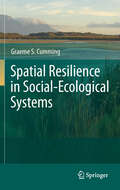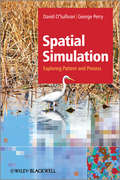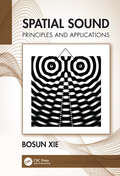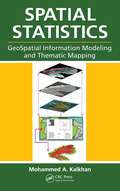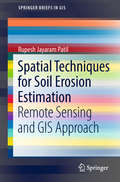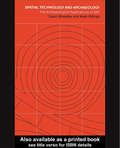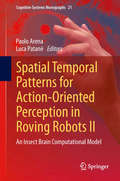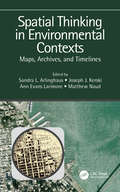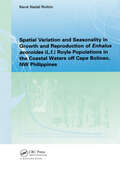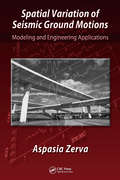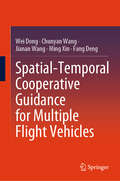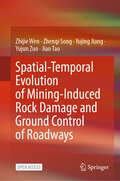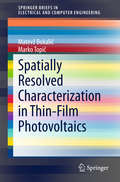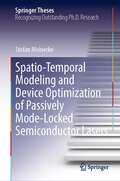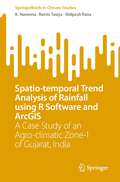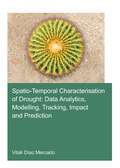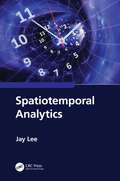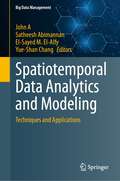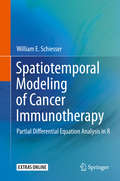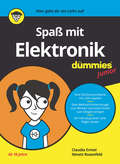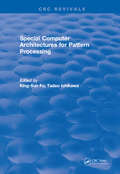- Table View
- List View
Spatial Resilience in Social-Ecological Systems
by Graeme S. CummingSpatial Resilience is a new and exciting area of interdisciplinary research. It focuses on the influence of spatial variation - including such things as spatial location, context, connectivity, and dispersal - on the resilience of complex systems, and on the roles that resilience and self-organization play in generating spatial variation. Prof. Cumming provides a readable introduction and a first comprehensive synthesis covering the core concepts and applications of spatial resilience to the study of social-ecological systems. The book follows a trajectory from concepts through models, methods, and case study analysis before revisiting the central problems in the further conceptual development of the field. In the process, the author ranges from the movements of lions in northern Zimbabwe to the urban jungles of Europe, and from the collapse of past societies to the social impacts of modern conflict. The many case studies and examples discussed in the book show how the concept of spatial resilience can generate valuable insights into the spatial dynamics of social-ecological systems and contribute to solving some of the most pressing problems of our time. Although it has been written primarily for students, this book will provide fascinating reading for interdisciplinary scientists at all career stages as well as for the interested public. "Graeme Cumming, central in the development of resilience thinking and theory, has produced a wonderful book on spatial resilience, the first ever on this topic. The book will become a shining star, a classic in the explosion of new ideas and approaches to studying and understanding social-ecological systems." Carl Folke, Stockholm Resilience Centre, Sweden
Spatial Similarity Relations in Multi-scale Map Spaces
by Haowen Yan Jonathan LiHow does one determine how similar two maps are? This book aims at the theory of spatial similarity relations and its application in automated map generalization, including the definitions, classification and features of spatial similarity relations. Included also are calculation models of spatial similarity relations between arbitrary individual objects and between arbitrary object groups, and the application of the theory in the automation of the algorithms and procedures in map generalization.
Spatial Simulation
by David O'Sullivan George L. PerryA ground-up approach to explaining dynamic spatial modelling for an interdisciplinary audience.Across broad areas of the environmental and social sciences, simulation models are an important way to study systems inaccessible to scientific experimental and observational methods, and also an essential complement to those more conventional approaches. The contemporary research literature is teeming with abstract simulation models whose presentation is mathematically demanding and requires a high level of knowledge of quantitative and computational methods and approaches. Furthermore, simulation models designed to represent specific systems and phenomena are often complicated, and, as a result, difficult to reconstruct from their descriptions in the literature. This book aims to provide a practical and accessible account of dynamic spatial modelling, while also equipping readers with a sound conceptual foundation in the subject, and a useful introduction to the wide-ranging literature.Spatial Simulation: Exploring Pattern and Process is organised around the idea that a small number of spatial processes underlie the wide variety of dynamic spatial models. Its central focus on three 'building-blocks' of dynamic spatial models - forces of attraction and segregation, individual mobile entities, and processes of spread - guides the reader to an understanding of the basis of many of the complicated models found in the research literature. The three building block models are presented in their simplest form and are progressively elaborated and related to real world process that can be represented using them. Introductory chapters cover essential background topics, particularly the relationships between pattern, process and spatiotemporal scale. Additional chapters consider how time and space can be represented in more complicated models, and methods for the analysis and evaluation of models. Finally, the three building block models are woven together in a more elaborate example to show how a complicated model can be assembled from relatively simple components.To aid understanding, more than 50 specific models described in the book are available online at patternandprocess.org for exploration in the freely available Netlogo platform. This book encourages readers to develop intuition for the abstract types of model that are likely to be appropriate for application in any specific context. Spatial Simulation: Exploring Pattern and Process will be of interest to undergraduate and graduate students taking courses in environmental, social, ecological and geographical disciplines. Researchers and professionals who require a non-specialist introduction will also find this book an invaluable guide to dynamic spatial simulation.
Spatial Sound: Principles and Applications
by Bosun XieSpatial sound is an enhanced and immersive set of audio techniques which provides sound in three-dimensional virtual space. This comprehensive handbook sets out the basic principles and methods with a representative group of applications: sound field and spatial hearing; principles and analytic methods of various spatial sound systems, including two-channel stereophonic sound, and multichannel horizontal and spatial surround sound; ambisonics; wavefield synthesis; binaural playback and virtual auditory display; recording and synthesis, and storage and transmission of spatial sound signals; and objective and subjective evaluation. Applications range from cinemas to small mobile devices. The only book to review spatial sound principles and applications extensively Covers the whole field of spatial sound The book suits researchers, graduate students, and specialist engineers in acoustics, audio, and signal processing.
Spatial Statistics: GeoSpatial Information Modeling and Thematic Mapping
by Mohammed A. KalkhanGeospatial information modeling and mapping has become an important tool for the investigation and management of natural resources at the landscape scale. Spatial Statistics: GeoSpatial Information Modeling and Thematic Mapping reviews the types and applications of geospatial information data, such as remote sensing, geographic information systems
Spatial Techniques for Soil Erosion Estimation: Remote Sensing And Gis Approach (Springerbriefs In Gis Ser.)
by Rupesh Jayaram PatilThis book presents a novel computation of the topographic LS factor of the USLE model to estimate spatial soil erosion. In developing countries, soil erosion is one of the main concerns as it adversely affects agriculture and reduces food production. Therefore, the author presents a particularly relevant approach, as he demonstrates how the C++ programming allows us to identify important erosion stages like detachment and deposition. He does this by assessing the annual rate of soil erosion from the Shakkar River watershed in India using distributed information and applying RS and GIS techniques. He also discusses different approaches that have been proposed to work out the influence of topography on erosion. Simulated and observed data of sediment loss are compared for the period 1992 to 2006.This book provides an easy-to-understand basic piece of soil erosion and hydrological research and reaches out to young researchers and students at the graduate and undergraduate level as well as applicants of soil erosion models.
Spatial Technology and Archaeology: The Archaeological Applications of GIS
by David Wheatley Mark GillingsGeographical Information Systems (GIS) and related spatial technologies have a new and powerful role to play in archaeological interpretation. Beginning with a conceptual approach to the representation of space adopted by GIS, this book examines spatial databases; the acquisition and compilation of data; the analytical compilation of data; the anal
Spatial Temporal Information Systems: An Ontological Approach using STK
by Linda M. McNeil T.S. KelsoDesigned to be a high-level, approachable resource for engineers who need further insight into spatial temporal information systems from an ontological perspective, Spatial Temporal Information Systems: An Ontological Approach using STK explains the dynamics of objects interaction from signal analysis to trajectory design, spatial modeling, and oth
Spatial Temporal Patterns for Action-Oriented Perception in Roving Robots II
by Paolo Arena Luca PatanèThis book presents the result of a joint effort from different European Institutions within the framework of the EU funded project called SPARK II, devoted to device an insect brain computational model, useful to be embedded into autonomous robotic agents. Part I reports the biological background on Drosophila melanogaster with particular attention to the main centers which are used as building blocks for the implementation of the insect brain computational model. Part II reports the mathematical approach to model the Central Pattern Generator used for the gait generation in a six-legged robot. Also the Reaction-diffusion principles in non-linear lattices are exploited to develop a compact internal representation of a dynamically changing environment for behavioral planning. In Part III a software/hardware framework, developed to integrate the insect brain computational model in a simulated/real robotic platform, is illustrated. The different robots used for the experiments are also described. Moreover the problems related to the vision system were addressed proposing robust solutions for object identification and feature extraction. Part IV includes the relevant scenarios used in the experiments to test the capabilities of the insect brain-inspired architecture taking as comparison the biological case. Experimental results are finally reported, whose multimedia can be found in the SPARK II web page: www. spark2. diees. unict. it
Spatial Thinking in Environmental Contexts: Maps, Archives, and Timelines
by Joseph J. Kerski Sandra L. Arlinghaus Ann Evans Larimore Matthew NaudSpatial Thinking in Environmental Contexts: Maps, Archives, and Timelines cultivates the spatial thinking "habit of mind" as a critical geographical view of how the world works, including how environmental systems function, and how we can approach and solve environmental problems using maps, archives, and timelines. The work explains why spatial thinking matters as it helps readers to integrate a variety of methods to describe and analyze spatial/temporal events and phenomena in disparate environmental contexts. It weaves together maps, GIS, timelines, and storytelling as important strategies in examining concepts and procedures in analyzing real-world data and relationships. The work thus adds significant value to qualitative and quantitative research in environmental (and related) sciences. Features Written by internationally renowned experts known for taking complex ideas and finding accessible ways to more broadly understand and communicate them. Includes real-world studies explaining the merging of disparate data in a sensible manner, understandable across several disciplines. Unique approach to spatial thinking involving animated maps, 3D maps, GEOMATs, and story maps to integrate maps, archives, and timelines—first across a single environmental example and then through varied examples. Merges spatial and temporal views on a broad range of environmental issues from traditional environmental topics to more unusual ones involving urban studies, medicine, municipal/governmental application, and citizen-scientist topics. Provides easy to follow step-by-step instructions to complete tasks; no prior experience in data processing is needed.
Spatial Variation and Seasonality in Growth and Reproduction of Enhalus Acoroides (L.f.) Royle Populations in the Coastal Waters Off Cape Bolinao, NW Philippines
by Rene. N. RollonThis text explores the spatial variation and seasonality in growth and reproduction of "Enhalus acoroides" (L.f.) Royle populations in the coastal waters off Cape Bolinao, NW Phillipines.
Spatial Variation of Seismic Ground Motions: Modeling and Engineering Applications (Advances in Engineering Series)
by Aspasia ZervaThe spatial variation of seismic ground motions denotes the differences in the seismic time histories at various locations on the ground surface. This text focuses on the spatial variability of the motions that is caused by the propagation of the waveforms from the earthquake source through the earth strata to the ground surface, and it brings toge
Spatial-Temporal Cooperative Guidance for Multiple Flight Vehicles
by Ming Xin Wei Dong Chunyan Wang Fang Deng Jianan WangThe spatial-temporal cooperative guidance problem for multiple flight vehicles has garnered significant attention in recent years due to its potential benefits in both military and civil fields. This book provides a concise but holistic introduction to this practical problem and presents a summative collection of the latest solutions to the concerned challenges, thereby providing some theoretical support for enhancing the synergism and applicability of cooperative guidance for multiple flight vehicles. This book consists of nine chapters. In Chapter 1, recent works on cooperative guidance are systematically recalled. Chapter 2 introduces the common formulation and unique challenges of the cooperative guidance problem from a practical viewpoint. In Chapter 3, a varying-gain proportional navigation guidance law with accurate time-to-go prediction is developed to realize precise control of the impact time. In Chapter 4, in response to the inherent finite-time property of the cooperative guidance problem, a fixed-time convergent error dynamic is proposed to design a 3D distributed cooperative guidance law with enhanced convergence. In Chapter 5, a command-decoupled design strategy is proposed to address the challenging spatial-temporal cooperative guidance problem through the derivation and combination of the coplanar cooperative guidance and planar pursuit guidance commands. In Chapter 6, an integrated design strategy based on rotational operations on spatial vectors is proposed to simultaneously satisfy the impact angle and time constraints. In Chapter 7, a multiple-stage cooperative guidance strategy is developed to satisfy the spatial-temporal constraints without relying on time-to-go information. In Chapter 8, a unified command augmentation method is proposed to prevent the seeker's FOV from exceeding the boundary throughout the cooperative guidance. Finally, Chapter 9 concludes this book and offers an instructive opinion on the future directions of the cooperative guidance problem in both academic and engineering investigations. Therefore, this book can not only serve as a reference for researchers who are interested in this field with systematic and inspirational perspectives, but also be a useful handbook for engineers engaged in cooperative guidance and control of multiple flight vehicles.
Spatial-Temporal Evolution of Mining-Induced Rock Damage and Ground Control of Roadways
by Jian Tao Yujing Jiang Zhijie Wen Zhenqi Song Yujun ZuoThis open access book presents the Coal remains the primary energy source in China, with an estimated total coal reserve of 59 trillion tons at depths of less than 2000 meters. Among these, over 50% lie at depths exceeding 1000 meters, primarily distributed in central and eastern China. Deep coal mining has become the new norm for the coal industry&’s development and resource exploitation. To ensure energy supply for the rapid economic development of central and eastern regions, mining coal resources from depths of over 1000 meters is inevitable. This endeavor holds significant strategic importance for safeguarding national energy security and supporting regional economic growth. However, mining-induced hazards, such as rock bursts, water inrushes, and roof collapses, continue to occur frequently in both local and state-owned coal mines. These incidents pose severe threats to the safety of coal production, tarnish the reputation of China's mining industry, and hinder its development. Therefore, advancing mining engineering—especially the theories of major accident prediction and control—is essential. A deeper understanding of the dynamic processes underlying mining-induced pressure and strata movement is necessary. Promoting safe and efficient coal mining through informed decision-making and management supported by scientific, quantitative methods is a critical and urgent task. Achieving informatization, intelligence, and visualization in mining operations will be key to fundamentally addressing the current safety challenges in China's mining industry. In recent years, the author and their team have conducted in-depth studies on models of dynamic disasters and surrounding rock control in deep mines, supported by projects under the National Basic Research Program (973 Program), the National Key R&D Program, as well as talent and general research funds and specialized consultancy projects from the Chinese Academy of Sciences. The main research focuses include constructing spatial structural models of overlying strata in mining areas, analyzing the spatiotemporal evolution of mining-induced stress, and developing proactive control technologies for dynamic disasters in mining areas. This book aims to provide foundational insights into the occurrence and control of major mining accidents. It proposes a decision-making framework for predicting and managing such disasters by controlling the movement of surrounding rock and stress conditions induced by mining. These efforts are expected to provide a reference for advancing research in related fields.
Spatially Resolved Characterization in Thin-Film Photovoltaics
by Matevž Bokalič Marko TopičThe book is devoted to the spatial characterization of solar cells and PV modules. It is written both as a monograph as well as a succinct guide for the state-of-the-art spatial characterization techniques and approaches. Amongst the approaches discussed are visual imaging, electro- and photo-luminescence imaging, thermography, and light beam induced mapping techniques. Emphasis is given on the luminescence image acquisition and interpretation due to its great potential. Characterization techniques are accompanied by simulation tools. The contents are aimed at a readership of students and senior researchers in R&D as well as engineers in industry who are newcomers to the spatial characterization of either solar cells or PV modules. The concepts and approaches presented herein are based on but not limited to case studies of real thin-film PV devices. Key features: Review of spatially resolved characterization techniques and accompanying SPICE simulations in photovoltaics Use of spatially resolved characterization techniques and their combinations for the identification of inhomogeneities in small area CdTe and dye-sensitized solar cells Case studies of electroluminescence imaging of commercial PV modules (c-Si, CIGS, CdTe, a-Si, tandem and triple junction thin-film-Si) The contents are aimed at a readership of students and senior researchers in R&D as well as engineers in industry who are newcomers to the spatial characterization of either solar cells or PV modules. The concepts and approaches presented herein are based on but not limited to case studies of real thin-film PV devices. Key features: Review of spatially resolved characterization techniques and accompanying SPICE simulations in photovoltaics Use of spatially resolved characterization techniques and their combinations for the identification of inhomogeneities in small area CdTe and dye-sensitized solar cells Case studies of electroluminescence imaging of commercial PV modules (c-Si, CIGS, CdTe, a-Si, tandem and triple junction thin-film-Si)
Spatio-Temporal Modeling and Device Optimization of Passively Mode-Locked Semiconductor Lasers (Springer Theses)
by Stefan MeineckeThis thesis investigates passively mode-locked semiconductor lasers by numerical methods. The understanding and optimization of such devices is crucial to the advancement of technologies such as optical data communication and dual comb spectroscopy. The focus of the thesis is therefore on the development of efficient numerical models, which are able both to perform larger parameter studies and to provide quantitative predictions. Along with that, visualization and evaluation techniques for the rich spatio-temporal laser dynamics are developed; these facilitate the physical interpretation of the observed features.The investigations in this thesis revolve around two specific semiconductor devices, namely a monolithically integrated three-section tapered quantum-dot laser and a V-shaped external cavity laser. In both cases, the simulations closely tie in with experimental results, which have been obtained in collaboration with the TU Darmstadt and the ETH Zurich. Based on the successful numerical reproduction of the experimental findings, the emission dynamics of both lasers can be understood in terms of the cavity geometry and the active medium dynamics. The latter, in particular, highlights the value of the developed simulation tools, since the fast charge-carrier dynamics are generally not experimentally accessible during mode-locking operation. Lastly, the numerical models are used to perform laser design explorations and thus to derive recommendations for further optimizations.
Spatio-temporal Trend Analysis of Rainfall using R Software and ArcGIS: A Case Study of an Agro-climatic Zone-1 of Gujarat, India (SpringerBriefs in Climate Studies)
by K. Naveena Ramiz Tasiya Shilpesh RanaThis book aims to provide an advanced R software approach that can carry out rainfall trend analysis using Mann-Kendall and Sen’s slope estimator tests. The research study follows a systematic approach while utilizing R software as it can greatly facilitate the analysis of rainfall trends. About 30 stations located in the study area and 41 to 50 years’ time series were selected for the purpose of analysis. The data for the research was collected from the State Water Data Centre (SWDC) in Gujarat, Indian Meteorological Department (IMD) in Pune, DAAC (NASA), and ESRI. Cluster analysis has been performed to analyze the variability of the mean rainfall. The stations have been divided into 2 clusters with 17 and 13 stations in each cluster which significantly differ from each other. This book is aimed at researchers, scientists and government organizations working in the field of climate change.
Spatio-temporal characterisation of drought: data analytics, modelling, tracking, impact and prediction (IHE Delft PhD Thesis Series)
by Vitali Diaz MercadoStudies of drought have increased in light of new data availability and advances in spatio-temporal analysis. However, the following gaps still need to be filled: 1) methods to characterise drought that explicitly consider its spatio-temporal features, such as spatial extent (area) and pathway; 2) methods to monitor and predict drought that include the above-mentioned characteristics and 3) approaches for visualising and analysing drought characteristics to facilitate interpretation of its variation. This research aims to explore, analyse and propose improvements to the spatio-temporal characterisation of drought. Outcomes provide new perspectives towards better prediction. The following objectives were proposed. 1) Improve the methodology for characterising drought based on the phenomenon’s spatial features. 2) Develop a visual approach to analysing drought variations. 3) Develop a methodology for spatial drought tracking. 4) Explore machine learning (ML) techniques to predict crop-yield responses to drought. The four objectives were addressed and results are presented. Finally, a scope was formulated for integrating ML and the spatio-temporal analysis of drought. Proposed scope opens a new area of potential for drought prediction (i.e. predicting spatial drought tracks and areas). It is expected that the drought tracking and prediction method will help populations cope with drought and its severe impacts.
Spatiotemporal Analytics
by Jay LeeThis book introduces readers to spatiotemporal analytics that are extended from spatial statistics. Spatiotemporal analytics help analysts to quantitatively recognize and evaluate the spatial patterns and their temporal trends of a set of geographic events or objects. Spatiotemporal analyses are very important in geography, environmental sciences, economy, and many other domains. Spatiotemporal Analytics explains in very simple terms the concepts of spatiotemporal data and statistics, theories, and methods used. Each chapter introduces a case study as an example application for an in-depth learning process. The software used and the codes provided enable readers not only to learn statistics but also to use them effectively in their projects. • Provides a comprehensive understanding of spatiotemporal analytics to readers with minimum knowledge in statistics. • Written in simple, understandable language with step-by-step instructions. • Includes numerous examples for all theories and methods explained in the book covering a wide range of applications from different disciplines. • Each application includes a software code needed to follow the instructions. • Each chapter also has a set of prepared PowerPoint slides to help spatiotemporal analytics instructors explain the content. Undergraduate and graduate students who use Geographic Information Systems or study Geographical Information Science will find this book useful. The subject matter is also pertinent to an array of disciplines such as agriculture, anthropology, archaeology, architecture, biology, business administration and management, civic engineering, criminal justice, epidemiology, geography, geology, marketing, political science, and public health.
Spatiotemporal Data Analytics and Modeling: Techniques and Applications (Big Data Management)
by El-Sayed M. El-Alfy John A Satheesh Abimannan Yue-Shan ChangWith the growing advances in technology and transformation to digital services, the world is becoming more connected and more complex. Huge heterogeneous data are generated at rapid speed from various types of sensors. Augmented with artificial intelligence and machine learning and internet of things, latent relations, and new insights can be captured helping in optimizing plans and resource utilization, improving infrastructure, and enhancing quality of services. A “spatial data management system” is a way to take care of data that has something to do with space. This could include data such as maps, satellite images, and GPS data. A temporal data management system is a system designed to manage data that has a temporal component. This could include data such as weather data, financial data, and social media data. Some advanced techniques used in spatial and temporal data management systems include geospatial indexing for efficient querying and retrieval of location-based data, time-series analysis for understanding and predicting temporal patterns in datasets like weather or financial trends, machine learning algorithms for uncovering hidden patterns and correlations in large and complex datasets, and integration with Internet of Things (IoT) technologies for real-time data collection and analysis. These techniques, augmented with artificial intelligence, enable the extraction of latent relations and insights, thereby optimizing plans, improving infrastructure, and enhancing the quality of services. This book provides essential technical knowledge, best practices, and case studies on the state-of-the-art techniques of artificial intelligence and machine learning for spatiotemporal data analysis and modeling. The book is composed of several chapters written by experts in their fields and focusing on several applications including recommendation systems, big data analytics, supply chains and e-commerce, energy consumption and demand forecasting,and traffic and environmental monitoring. It can be used as academic reference at graduate level or by professionals in science and engineering related fields such as data science and engineering, big data analytics and mining, artificial intelligence, machine learning and deep learning, cloud computing, and internet of things.
Spatiotemporal Dynamics of Meteorological and Agricultural Drought in China
by Yi Li Guang Yang Asim Biswas Faliang Yuan Qiang Zhou Fenggui Liu Zhihao LiaoThis book explores spatiotemporal analysis and impact assessment of agricultural drought in China and investigates the correlation coefficient between meteorological drought and agricultural drought. It then conducts multivariate frequency analysis of drought events using drought indices and copula functions. It aims to reveal spatiotemporal characteristics and impacts of agricultural drought in China both on vegetation phenology and productivity. The book assesses the performances of drought indices for better predicting multi-year droughts and return periods and drought risk assessment.
Spatiotemporal Modeling of Cancer Immunotherapy: Partial Differential Equation Analysis in R
by William E. SchiesserThe focus of this book is a detailed discussion of a dual cancer vaccine (CV)-immune checkpoint inhibitor (ICI) mathematical model formulated as a system of partial differential equations (PDEs) defining the spatiotemporal distribution of cells and biochemicals during tumor growth.A computer implementation of the model is discussed in detail for the quantitative evaluation of CV-ICI therapy. The coding (programming) consists of a series of routines in R, a quality, open-source scientific computing system that is readily available from the internet. The routines are based on the method of lines (MOL), a general PDE algorithm that can be executed on modest computers within the basic R system. The reader can download and use the routines to confirm the model solutions reported in the book, then experiment with the model by varying the parameters and modifying/extending the equations, and even studying alternative models with the PDE methodology demonstrated by the CV-ICI model.Spatiotemporal Modeling of Cancer Immunotherapy: Partial Differential Equation Analysis in R facilitates the use of the model, and more generally, computer- based analysis of cancer immunotherapy mathematical models, as a step toward the development and quantitative evaluation of the immunotherapy approach to the treatment of cancer.
Spaß mit Elektronik für Dummies Junior (Für Dummies)
by Claudia Ermel Ninett RosenfeldBastelst du gern? Und liebst du es, wenn es leuchtet, piept und blinkt? In diesem Buch erfährst du Schritt für Schritt, wie du mit LEDs, Kondensatoren, Transistoren, Widerständen und anderen elektronischen Bauteilen nützliche und schöne Dinge wie Glückwunschkarten, Geschicklichkeitsspiele, Gespenster, Weihnachtsschmuck und Spielzeugautos basteln kannst. Du wirst von Anfang an auch löten! Nebenher lernst du, was Strom ist, warum man dafür Spannung braucht und wie alles funktioniert. Die Bauteile kannst du dir für wenig Geld im Internet oder im Elektronikmarkt besorgen. Leg einfach los! Bestens geeignet für Kinder und Jugendliche ab 10 Jahren.
Spears of God
by Howard V. HendrixIn the early decades of the twenty-first century, the most commonly held truth is that knowledge is power. Yet a select few men and women begin to suspect what few will admit: we know nothing at all. The world’s oil resources have dwindled. The rich are turning richer and the power-mongers are becoming more powerful. China and the United States dominate the globe in a geopolitical chess match. The human mind has merged with the cybergrid, yet the human race seems not to have evolved much at all. ...
Special Computer Architectures for Pattern Processing
by King-Sun FuIt has been recognized for a long time that a conventional sequential processor is inefficient for operations on pictorial data where relatively simple operations need to be performed on a large number of data elements (pixels). Though many parallel processing architectures for picture processing have been proposed in the past, very few have actually been implemented due to the costs involved. With LSI technology, it is becoming possible to realize parallel architectures at a modest cost. In the following the authors review some of the proposed architectures for pattern recognition and image processing.
